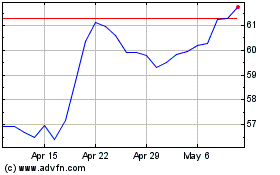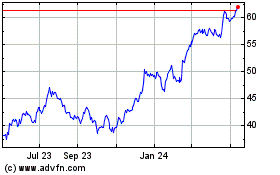By Emily Glazer
As Wells Fargo & Co.'s sales-tactics scandal unfolded,
investors, regulators and politicians asked how improper practices
could have persisted for so long. One possible reason: bank
branches were given a heads up before Wells Fargo's internal
monitors landed for inspections.
Managers and employees at the bank's roughly 6,000 branches
across the U.S. typically had at least 24 hours' warning about
annual reviews conducted by risk employees, current and former
Wells Fargo employees and executives said. That gave many employees
time to cover up improper practices, such as opening accounts or
signing customers up for products without their knowledge.
More than a dozen current and former employees of the bank
across California, Arizona and New Jersey, for instance, said they
forged or saw colleagues forge signatures on documents or shred
papers that could have indicated accounts were opened without
authorization.
Often, managers would call for all hands on deck at a branch to
stay late into the evening -- or sometimes all night -- to shred
documents or forge signatures if they weren't there, some current
and former managers said.
For instance, they would go through desks to find signature
cards that hadn't been approved, make sure wire forms had been
filled out properly and that documents in a "control binder" like
cash or teller audits were filled out, said Ivan Rodriguez, a
former branch banker at Wells Fargo for about six years until
2013.
Some branches that opened accounts for customers without the
customer present would cut and paste a signature the bank had on
file for the customer and add it to the required signature card,
Mr. Rodriguez said.
"You became numb to it," he added. "It became pretty
normal."
A Wells Fargo spokeswoman said the bank has boosted oversight,
monitoring and accountability so unethical practices don't happen
again. That includes investing millions in staffing, mystery shops
by a third party, unannounced branch inspections on employee sales
behavior and an increase in branch visits by its internal
auditors.
The bank has been under fire since September when it entered a
$185 million settlement and enforcement action with regulators and
a city official over opening as many as 2.1 million accounts using
fictitious or unauthorized information. Wells Fargo still faces a
spate of state and federal investigations, including from the
Justice Department and the Securities and Exchange Commission.
In the scandal's wake, Wells Fargo has been changing procedures
and trying to tighten internal checks, said Vic Albrecht, who has
led risk management for the retail bank since September. Last fall,
it piloted a surprise sales-practices inspection that previously
didn't exist to ensure there isn't undue sales pressure and
customers get appropriate products, among other checks, he
said.
Around 100 of these "Conduct Risk Reviews" have been completed
based on possible risks or complaints. Top retail-banking
executives who typically oversee hundreds of branches, risk
executives and company lawyers are aware of the results, Mr.
Albrecht said.
But the other system, now known as "Branch Control Review,"
still gives a 24-hour notice so branch managers can staff
appropriately and it doesn't interrupt customer service, he said,
though advance notice and other parts of the review could change in
the future. It measures "operational integrity," according to an
internal bank document reviewed by The Wall Street Journal. That
system, alongside the bank's "Quality of Sales Report Card" that
checks signatures, procedures and funding, are part of a new branch
"risk score." This will be factored into employees' compensation
under a new plan rolled out to staff this month, according to plan
documents.
Bank-branch audits are common in the industry, especially to try
to spot risks related to large transactions, paperwork logs and
cash shipments. Other big banks, such as Bank of America Corp.,
Citigroup Inc. and J.P. Morgan Chase & Co. typically have
surprise branch audits, or checks, at least once a year, said
people familiar with the banks, who added that branches didn't get
notice ahead of time.
"They need to audit business as usual, not to see somebody put
on their Sunday best clothes," said Jeffrey Sonnenfeld, professor
and associate dean for leadership studies at Yale School of
Management. "Mystery shoppers...don't give advance notice to the
stores that they're coming."
Banks are expected to have three lines of defense to spot
irregularities or problems: its business executives,
risk-management professionals and internal auditors. The board of
directors is supposed to add another layer for checks and balances.
It appears some of these were lacking at Wells Fargo, according to
regulators.
"Had these structure elements been functioning properly, they
would have prevented the type of abuses we have witnessed at Wells
Fargo," Thomas Curry, head of the Office of the Comptroller of the
Currency, said at one of two congressional hearings about the
bank's sales practices.
At Wells Fargo, retail-bank risk executives -- some branch
employees called them auditors -- typically traveled district by
district to check on branches, some current and former employees
said. But retail-bank executives would usually receive anywhere
from 24 to 72 hours' notice of the inspections, and branch managers
typically got one day's heads up, these people said.
Some of those bank managers would meet with operations staff in
their districts to discuss issues auditors were finding so they
could fix those in advance of another audit, one of these people
said.
Internally, the advance notice -- known to some within the bank
as an open-book test -- was considered standard, these people said.
Only in recent years did much of the operational-control checks
move to electronic forms auditors would gather in advance, making
it harder for branch employees to fake records.
The inspectors would examine, for instance, how many accounts
were funded, whether signature cards existed for accounts opened in
the last 90 days, and if employees knew the opening and closing
procedures of the branch, among other checks, these people
said.
"The volume of business you did was humongous, so the dotting of
Is and the crossing of Ts was not that great," one of these people
said. "Growing the business was primary: the more successful you
were, the higher the goals were. So you had to keep up."
Write to Emily Glazer at emily.glazer@wsj.com
(END) Dow Jones Newswires
January 24, 2017 05:44 ET (10:44 GMT)
Copyright (c) 2017 Dow Jones & Company, Inc.
Wells Fargo (NYSE:WFC)
Historical Stock Chart
From Mar 2024 to Apr 2024

Wells Fargo (NYSE:WFC)
Historical Stock Chart
From Apr 2023 to Apr 2024
